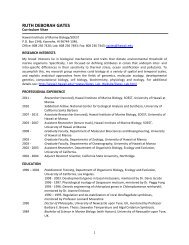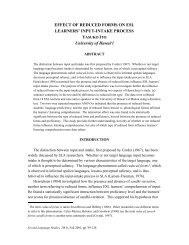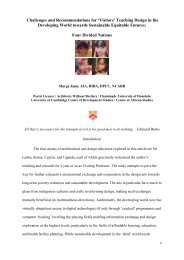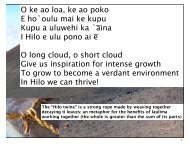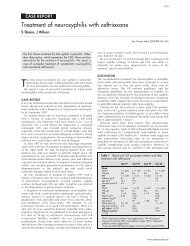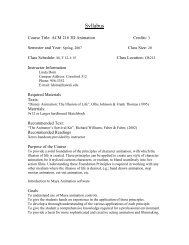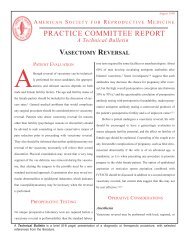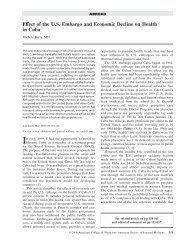Tying and Untying the Trouser-Cord - University of Hawaii
Tying and Untying the Trouser-Cord - University of Hawaii
Tying and Untying the Trouser-Cord - University of Hawaii
You also want an ePaper? Increase the reach of your titles
YUMPU automatically turns print PDFs into web optimized ePapers that Google loves.
68 J. W. Frembgen<br />
delivered, he unties a knot, <strong>and</strong> by <strong>the</strong> time he has completed his task all <strong>the</strong> knots are untied’.<br />
(1960, p. 87)<br />
[22] Not only as an item <strong>of</strong> basic need to prevent <strong>the</strong> trousers from slipping down, but occasionally<br />
also in case <strong>of</strong> car repairs to fasten <strong>the</strong> exhaust pipe or to use as a drive-belt (Asad Qizilbash,<br />
pers. comm.).<br />
[23] That means that, contrary to Banerjee’s <strong>and</strong> Miller’s statement (based on modern India) that<br />
‘<strong>the</strong> shalwar kamiz has become <strong>the</strong> garment that st<strong>and</strong>s for functionalism <strong>and</strong> <strong>the</strong> power<br />
associated with pragmatism <strong>and</strong> efficiency’ (2003, p. 246), <strong>the</strong>re is a clear ambiguity inherent<br />
in <strong>the</strong> use <strong>of</strong> <strong>the</strong> trouser-cord as <strong>the</strong> essential accessory <strong>of</strong> wearing shalwar-qamiz . Thus, at<br />
least with respect to <strong>the</strong> Punjab <strong>and</strong> o<strong>the</strong>r parts <strong>of</strong> Pakistan, <strong>the</strong> dress is not as ‘rational’ as<br />
<strong>the</strong>se authors make us believe.<br />
[24] Banerjee <strong>and</strong> Miller (2003, pp. 31, 34, 37, 85 /6). On <strong>the</strong> sari ’s inherent ambiguity <strong>the</strong> authors<br />
conclude:<br />
The various ways in which <strong>the</strong> sari may be used to flirt <strong>and</strong> its deeper association<br />
with sexuality is entirely compatible with its portrayal <strong>and</strong> maintenance <strong>of</strong> modesty<br />
<strong>and</strong> its role as a form <strong>of</strong> veiling. Indeed, <strong>the</strong> ambiguity <strong>of</strong> <strong>the</strong> sari becomes an<br />
integral part <strong>of</strong> its effectiveness. Thus many <strong>of</strong> <strong>the</strong> woman’s movements achieve<br />
<strong>the</strong>ir power <strong>and</strong> nuance as an act <strong>of</strong> covering up while still betraying a possible hint<br />
<strong>of</strong> desire, or an exposure that is eroticised precisely because it is so subtle <strong>and</strong><br />
discreet, confirming <strong>the</strong> allure <strong>of</strong> modesty. (Banerjee & Miller 2003, pp. 88 /9)<br />
References<br />
Andrews, P. A. (1985) ‘Die Krönung der Braut: Zur turkmenischen Frauentracht in historischer<br />
Sicht’, in Die Braut , Vol. 2, eds G. Völger & K. von Welck, Rautenstrauch-Joest-Museum,<br />
Cologne, pp. 656 /69.<br />
Askari, N. & Arthur, L. (1999) Uncut Cloth: Saris, Shawls <strong>and</strong> Sashes, Merrell Holberton, London.<br />
Askari, N. & Crill, R. (1997) Colours <strong>of</strong> <strong>the</strong> Indus: Costume <strong>and</strong> Textiles <strong>of</strong> Pakistan , Merrell<br />
Holberton in association with <strong>the</strong> Victoria & Albert Museum, London.<br />
Banerjee, M. & Miller, D. (2003) The Sari , Berg, Oxford.<br />
Bianca, S. (1991) H<strong>of</strong>haus und Paradiesgarten: Architektur und Lebensformen in der islamischen Welt,<br />
C. H. Beck, Munich.<br />
Bouhdiba, A. (1975) La sexualité en Islam, Presses Universitaires de France, Paris.<br />
Bousquet, G-H. (1966) L’éthique sexuelle de l’Islam, G. P. Maisonneuve & Larose, Paris (1990 ed.<br />
Desclée de Brouwer).<br />
Burkhart, D. (1985) ‘Der rote Schleier: Zur traditionellen Brautausstattung bei den Türken und<br />
Bulgaren’, in Die Braut, Vol. 2, eds G. Völger <strong>and</strong> K. von Welck, Rautenstrauch-Joest-<br />
Museum, Cologne, pp. 450 /5.<br />
Chebel, M. (1997) Die Welt der Liebe im Islam: Eine Enzyklopädie , Antje Kunstmann, Munich.<br />
Classen, C. (1993) Worlds <strong>of</strong> Sense: Exploring <strong>the</strong> Senses in History <strong>and</strong> Across Cultures , Routledge,<br />
London <strong>and</strong> New York.<br />
Collingwood, P. (1988) Textile Strukturen, Paul Haupt, Berlin <strong>and</strong> Stuttgart.<br />
Coomaraswamy, A. K. (1944) ‘The iconography <strong>of</strong> Dürer’s ‘‘knots’’ <strong>and</strong> Leonardo’s ‘‘concatenation’’’,<br />
The Art Quarterly (Detroit Institute <strong>of</strong> Arts), vol. 7, pp. 109 /28.<br />
Creyaufmüller, W. (1983) Nomadenkultur in der Westsahara: Die materielle Kultur der Mauren, ihre<br />
h<strong>and</strong>werklichen Techniken und ornamentalen Grundstrukturen, Burgfried-Verlag, Hallein.<br />
Currie, P. M. (1989) The Shrine <strong>and</strong> Cult <strong>of</strong> Mu‘in al-Dîn Chishtî <strong>of</strong> Ajmer, Oxford <strong>University</strong> Press,<br />
Delhi.



